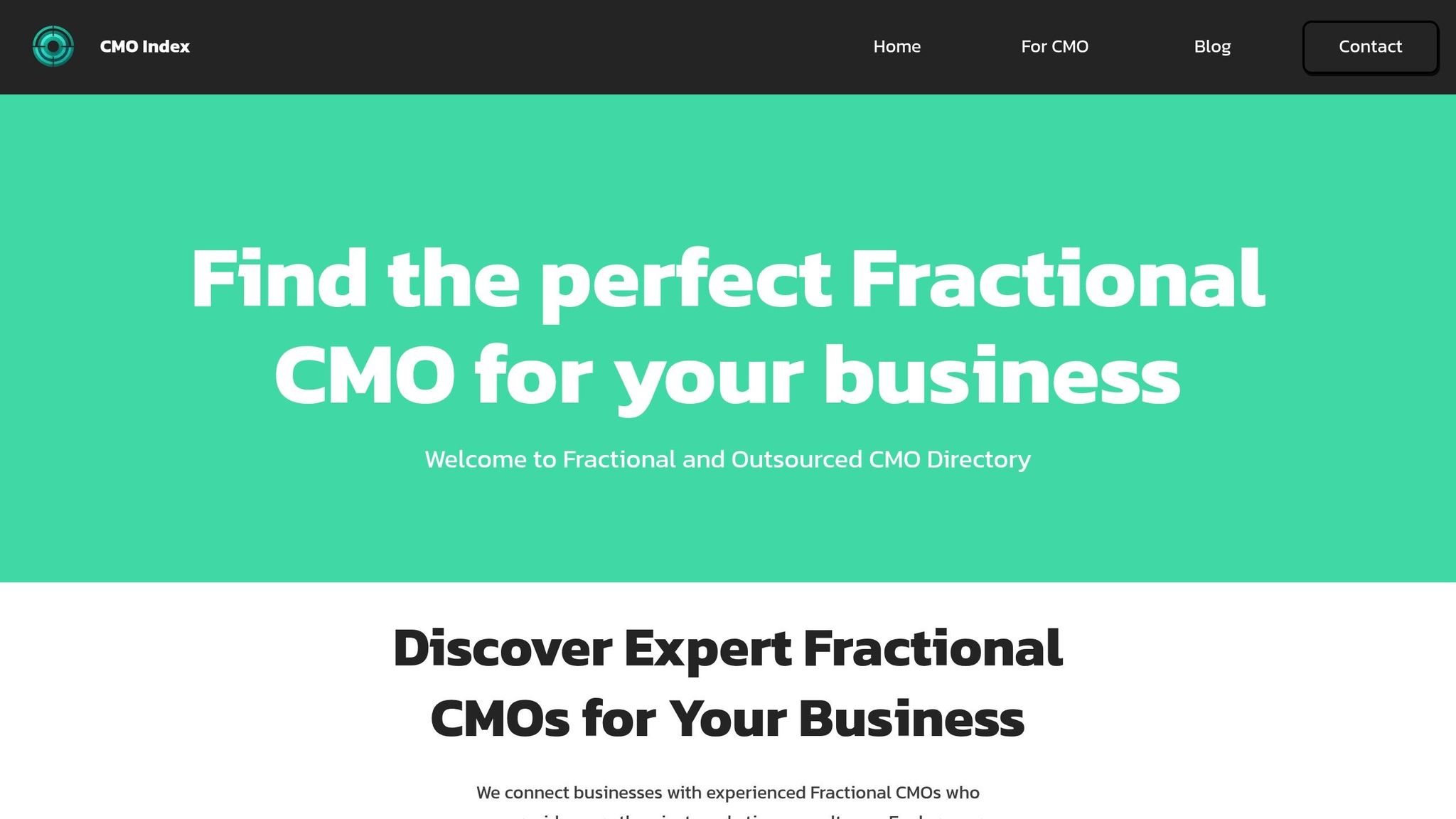Customer perception mapping helps businesses understand how customers view their brand compared to competitors. It creates visual maps based on customer feedback, showing how brands are positioned on key attributes like price, quality, or innovation. These maps reveal market gaps, strengths, and weaknesses, enabling companies to refine messaging, identify opportunities, and monitor competitors.
Key Takeaways:
- Understand Customer Views: See how your brand is perceived versus competitors.
- Spot Market Gaps: Identify unmet customer needs or underserved segments.
- Refine Messaging: Align communication with customer expectations.
- Track Competitors: Monitor shifts in the competitive landscape.
- Improve Team Alignment: Ensure internal teams understand customer perceptions.
Fractional CMOs can guide businesses, especially startups and SMEs, in creating and using these maps effectively. Platforms like CMO Index help connect companies with experienced marketing leaders for cost-effective solutions.
How To Make A Perceptual Map (Positioning Strategy Examples)
Key Benefits of Customer Perception Mapping
Customer perception mapping turns abstract customer opinions into clear, actionable insights that businesses can use to refine their strategies.
Finding Market Gaps and Opportunities
One of the standout advantages of perception mapping is its ability to uncover unmet customer needs - those "white space" opportunities where no brand currently delivers what customers are looking for. These gaps often highlight combinations of attributes, like affordability and luxury, that remain unaddressed. For example, if most brands cluster in the "high-price, high-quality" category, an "affordable luxury" space might emerge as a promising area for growth.
By analyzing these gaps through joint perceptual maps, businesses can merge customer perceptions with preferences to identify missing solutions. This creates a clear path for developing new products or repositioning existing ones to align directly with customer desires.
Instead of speculating about what customers might want, companies can design offerings that specifically target these gaps. However, not all gaps are worth pursuing - some may exist because they are either unprofitable or too challenging to serve effectively.
These insights naturally lead to a deeper evaluation of a brand’s internal strengths and weaknesses.
Discovering Brand Strengths and Weaknesses
Perception mapping provides an honest snapshot of how customers view your brand. It highlights your competitive edge while also exposing areas that need improvement.
For instance, if customers consistently associate your brand with being "innovative and reliable", you can amplify that positioning in your marketing. On the flip side, if your brand clusters with competitors in an overcrowded space, it’s a clear signal to differentiate yourself. The visual clarity of these maps makes it easier to prioritize which attributes need more focus and investment.
This balanced perspective helps businesses make targeted adjustments to their brand positioning.
Monitoring Competitive Positioning
Once gaps and strengths are identified, keeping an eye on your competitors becomes crucial. Perception maps allow for regular updates to track shifts in the market, whether it’s new product launches, updated messaging, or changes in customer perceptions.
This ongoing monitoring helps businesses stay ahead of market trends. For instance, if competitors begin to encroach on your territory or new players enter the market, you can adjust your strategy in time to protect your position. The dynamic nature of these maps ensures that your brand remains relevant and competitive in a constantly changing landscape.
Step-by-Step Process for Creating a Customer Perception Map
Building a customer perception map is all about turning customer feedback into a clear, visual representation of how brands are perceived. The process involves three main steps: gathering customer data, plotting brands on the map, and regularly analyzing and updating the map to keep it relevant.
Collecting Customer Data
Start by gathering insights directly from your audience through surveys, interviews, or focus groups. Use tools like rating scales or semantic differential scales (e.g., "traditional vs. modern") to measure customer opinions on key attributes. Make sure your data represents your target market accurately - this is the foundation for understanding how consumers view your brand and its competitors. Without solid data, your map won’t reflect reality.
Plotting Brands on the Map
Once you’ve collected the data, it’s time to create the map. Use a two-dimensional graph where each axis represents an attribute that matters most to your customers. Examples of these attributes might include "Quality vs. Price", "Innovation vs. Reliability," or "Traditional vs. Modern".
To make the map meaningful, include at least ten competitors. Plot them first to see how customers perceive each brand. Then, position your own brand based on the same insights. Pay close attention to any blank spaces on the map - these could indicate untapped opportunities in the market.
Reading and Updating the Map
Your customer perception map isn’t static - it’s a living tool. A well-designed map will reveal market gaps and clusters of competition. To keep it useful, update it regularly to reflect changes in customer opinions and market trends. By tracking how brands shift over time, you’ll stay ahead of the curve and ensure your brand strategy stays aligned with customer expectations.
sbb-itb-5c5ac24
Using Insights to Improve Brand Positioning
Once you've updated your perception map, the real work begins - turning those insights into actions that align your brand with customer expectations and market opportunities. It’s not just about identifying patterns; it’s about translating them into strategies that make a tangible difference.
Matching Brand Messaging with Customer Expectations
Your perception map highlights the gap between how you want your brand to be seen and how customers actually perceive it. This mismatch often stems from messaging that doesn’t fully connect with your audience’s values and priorities.
For instance, if your map shows that customers view your brand as “expensive but low quality” while your goal is to be seen as “premium and reliable,” it’s time to rethink your messaging. Identify the qualities your customers care about most and ensure your communication reflects those priorities.
Start by reviewing your messaging across all channels - your website, social media, advertisements, and even customer service scripts. Replace vague corporate jargon with language that speaks directly to the attributes your customers value. For example, if trust matters more to your audience than innovation, focus on showcasing reliability through testimonials, case studies, and proven results.
Visual branding also plays a crucial role in shaping perceptions. Elements like colors, fonts, and imagery should reinforce the message you’re trying to send. If you’re aiming to shift from a “traditional” to a “modern” brand image, your visuals need to reflect that evolution. Consistent messaging and visuals set the foundation for taking advantage of untapped market opportunities.
Using Market Gaps for Growth
The empty spaces on your perception map aren’t just blank - they’re opportunities waiting to be explored. These gaps often represent unmet customer needs or underserved market segments where no competitor currently stands out.
When you spot a promising gap, ask yourself whether your brand can realistically fill it. Consider your current resources, capabilities, and brand reputation. For example, transitioning from “budget-friendly” to “premium” might require a significant overhaul of your product quality, customer experience, and brand identity. On the other hand, smaller shifts - like moving from “reliable but boring” to “reliable and user-friendly” - are often more manageable and cost-effective.
Let these gap insights guide your product development efforts. If your map shows a demand for “high-quality, affordable” options, use this knowledge to shape your next product launch or service offering. Targeting these untapped spaces can lead to stronger customer loyalty and better margins.
Aligning Internal and External Brand Perceptions
While your perception map clarifies how customers see your brand, it’s equally important to ensure your internal teams are on the same page. One of the most eye-opening aspects of perception mapping is discovering how your team’s view of the brand differs from that of your customers.
For example, if customers describe your brand as “helpful but slow,” it’s crucial that your customer service team understands this perception and focuses on improving response times. When internal decisions are based on outdated or inaccurate views of the brand, it creates a disconnect that pulls you further away from meeting customer expectations.
To address this, conduct regular internal audits. Survey employees to understand how they perceive the brand, then compare their responses to your customer perception map. Any major discrepancies highlight areas where internal communication and training need attention.
This alignment also requires operational changes. If your goal is to move toward a “customer-centric” position, your policies, procedures, and incentives must prioritize customer satisfaction over internal convenience. Every interaction - whether it’s a customer call or a social media reply - should reinforce the brand image you’re working to achieve.
Getting internal and external perceptions to align becomes especially critical during periods of brand repositioning. When you’re actively trying to change how customers see you, your entire organization needs to rally behind the new direction. Mixed messages from different departments can confuse customers and derail your efforts, so consistency across the board is essential.
Role of Fractional CMOs in Customer Perception Mapping
Customer perception mapping might seem straightforward, but putting it into practice requires a level of expertise that many startups and small-to-medium enterprises (SMEs) simply don’t have in-house. This is where fractional CMOs step in. They bring the knowledge and skills of a seasoned marketing executive, helping businesses unlock the full potential of perception maps. For agile businesses, this makes fractional CMOs an ideal solution.
Why Fractional CMOs Are a Good Fit for Startups and SMEs
For growing businesses, having senior marketing leadership is crucial, but hiring a full-time executive isn’t always financially feasible. Fractional CMOs solve this problem by offering their expertise on a part-time or project basis, making it a budget-friendly option. With experience across various industries, they can spot trends, strengths, and weaknesses that internal teams might miss. Their tried-and-true methods can speed up the process of creating and executing an effective customer perception mapping strategy.
Another advantage of hiring a fractional CMO is their fresh perspective. Internal teams can sometimes overlook critical aspects of their brand due to familiarity. A fractional CMO, as an outsider, can provide an unbiased assessment, identify blind spots, and ask tough questions that lead to actionable insights. Their flexible approach is especially useful for projects that require intense focus initially and periodic updates as market conditions shift.
How CMO Index Simplifies Finding the Right Fractional CMO

Finding the right fractional CMO for customer perception mapping can feel like a daunting task. That’s where CMO Index comes in. It provides a curated directory of seasoned marketing professionals who specialize in areas like brand positioning and customer analysis. This platform allows businesses to compare CMOs based on their experience with similar projects, making the selection process much more straightforward.
CMO Index serves companies across a wide range of industries, ensuring that businesses can connect with marketing leaders who truly understand their unique challenges and market dynamics. Whether a company needs someone to lead the entire perception mapping process or to guide an internal team, CMO Index helps find the right expert for the job.
Speeding Up the Implementation of Perception Mapping Insights
Beyond just creating perception maps, fractional CMOs excel at turning insights into action. Many businesses struggle to move past the analysis phase, delaying important decisions and changes.
Fractional CMOs bring the expertise to bridge this gap. They can quickly identify the most impactful opportunities, set realistic timelines for implementing changes, and tap into their network of partners - like research vendors and design agencies - to get things moving efficiently. This ability to streamline the process ensures that businesses can act on insights faster, improving their brand positioning without unnecessary delays.
Conclusion
Customer perception mapping is a powerful tool that reveals the gap between how brands see themselves and how customers actually view them. By bridging this divide, businesses can align their strategies more effectively with customer expectations and market realities.
Key Takeaways
- Spotting market gaps and opportunities: This helps businesses uncover underserved segments and position themselves to meet unmet needs.
- Identifying brand strengths and weaknesses: Understanding what works and what doesn't allows companies to refine their messaging and focus on areas that need attention.
- Keeping an eye on competitors: By monitoring competitive positioning, businesses can stay agile and respond to shifts in the market landscape.
The process itself - gathering customer data, mapping brands, and continuously updating the map - is straightforward and actionable. The real benefit comes from turning these insights into tangible results, such as refining brand messaging, capitalizing on market opportunities, and aligning internal perceptions with customer views.
For startups and small-to-medium enterprises (SMEs), fractional CMOs provide an effective way to implement these strategies. These experienced professionals bring the expertise needed to transform analysis into action, offering a cost-effective alternative to full-time marketing leadership. This makes strategic marketing guidance accessible for growing businesses.
Final Thoughts on Using Customer Perception Mapping
Perception mapping isn’t a one-and-done task - it’s an evolving practice that grows with your business and market. Companies that regularly update their maps and adjust their strategies based on these insights are the ones that thrive.
Expert leadership often plays a critical role in successful mapping efforts. Platforms like CMO Index connect businesses with seasoned fractional CMOs who specialize in brand positioning and customer analysis. These professionals not only help craft detailed perception maps but also guide businesses in executing strategies that lead to measurable growth.
Whether you’re launching a new product, entering a new market, or strengthening your brand, acting quickly on insights from perception mapping - especially with expert guidance - can make all the difference.
FAQs
How can businesses keep their customer perception maps accurate and relevant over time?
To ensure customer perception maps stay accurate and useful, businesses need to update them regularly. Keeping an eye on changes in consumer preferences and market trends is crucial, especially after significant events like product launches, rebranding, or shifts in the competitive landscape.
Another essential step is incorporating ongoing customer feedback. Gathering insights through surveys, reviews, and other feedback channels helps businesses spot changes in how their brand is perceived. By analyzing this data and making timely adjustments, companies can keep their perception maps aligned with reality. This proactive approach ensures these maps remain a dependable resource for refining brand positioning.
What challenges do businesses face when aligning internal and customer perceptions, and how can they address them?
One frequent hurdle businesses face is dealing with data silos - isolated pockets of information that block teams from sharing insights efficiently. Add outdated technology and vague objectives into the mix, and understanding customer needs and expectations becomes even harder.
To tackle these challenges, companies should consider adopting integrated data systems that offer a comprehensive view of customer behavior. Establishing clear metrics to measure customer experience and utilizing real-time insights can reveal any disconnect between customer perceptions and company goals. On top of that, regularly gathering feedback and offering targeted employee training aligned with customer expectations are key steps toward building stronger alignment and boosting engagement.
How can fractional CMOs help startups and small businesses leverage customer perception mapping to improve their brand positioning?
Fractional CMOs can be a game-changer for startups and small businesses when it comes to using customer perception mapping to sharpen their brand positioning. By diving into customer insights, they pinpoint the differences between how a brand is currently seen and how it wants to be seen. This helps refine messaging and develop marketing strategies that hit the mark.
These seasoned marketing professionals also focus on aligning efforts across departments, ensuring a seamless and consistent experience for customers that truly connects with the intended audience. On top of that, they set up systems to track customer preferences in real time. This keeps businesses nimble, ready to adjust to market shifts, and better positioned to boost engagement and satisfaction.



